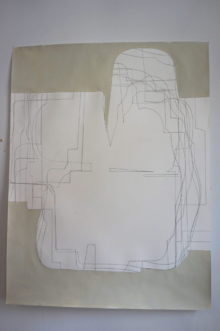Aspects of a generative drawing method
An art installation I made with compositions of secondhand furniture parts inspired me for a specific type of drawing. Because of the fascinating forms in these drawings and because of my interest in the physical way of making these drawings I investigated this way of drawing systematically. Gradually I developed a drawing method, resulting in autonomous drawings, video’s, installations, sculptures and photo’s. The following reflective text wants to highlight aspects of this drawing method, as part of my art practice. This account is about looking deeper into the formal mechanisms constituting the generative nature of the drawing method, but also about identifying the underlying desire to create a poetic mental space through drawing.
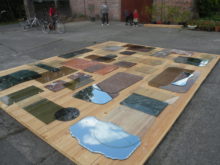
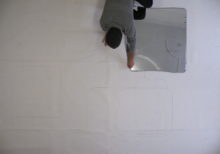
Tracing
The drawings arise from pencil tracings of glass and marble leftovers from second-hand furniture. The cabinets on which the marble and glass were lying have disappeared. When pencil tracings are made from the marble and glass tops, only the shape and the size of these flat objects refer as a distant echo to the original furniture. The shapes of the tracings contain a specific typology. In the size of the tracings one recognizes the human scale and an aspect of the previous function. The tracings still contain a level of reference to the original object, but generally they seem abstract and trigger the imagination. They are like the frame of a white canvas, asking to be filled in. In the tracings new spatialities and materialities can be imagined, not as a nostalgic approach but rather as a desire to create poetic entities.
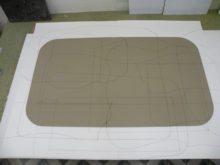
Imagining through connectivity
Connectivity is being examined through the different acts in the drawing process. Connectivity through overlap of tracings, through the closeness of traced form, in-between spaces, and continuous and discontinuous lines. I investigate how pencil lines and the zones around pencil lines can act as visual connection between shapes; the way lines connect form can be interpreted as stitching’s in clothing. There where the connections happen the graphical quality in the drawing appears. Tracings that touch or overlap trigger the imagination about connectivity. New spatial entities are in the make.
Each tracing of a second-hand furniture part possess specific curves. When different tracings are combined and connected and eventually filled in with colour pencil or painted they start to look like body parts, or they achieve a skin like quality or appear like clothing’s covering something.
The generic and the creative act
The drawing method possess a strong generic component. It consists of a set of convertible drawing acts: pencil tracings alongside the glass and marble objects, colour pencil hatchings, cutting out or etching forms, and overpainting parts. By alternately applying these acts I try to reach a point where a new spatiality can be imagined.
Every act is equally important and will be repeated in slightly different ways. The drawing act itself constantly develops as a creative response to the former act. It is in the overlap of the different acts and the creative response to each act, that the imagination is triggered, and a delicate world sees the light. The drawing method functions like a chain reaction of creative decisions. It is a construction that arise from the making itself. In the final results these drawings show traces of this momentum of speculation; not as deliberate traces, but as residues of the need to respond to former acts.
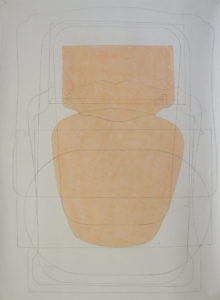
The tracing line as a clear border
I look for clear boundaries in the drawings by accentuating the tracing lines. By means of the two-dimensional traces of the marble or glass sheets I wish to start a process of imagination of the three-dimensional in the drawing. A tight tracing is the starting point from where the imagination of the three dimensional can take place. It is as if the defined form wants to come lose from the paper. The tracings define a precise field. They define a clear border, within which I can create poetic and aesthetic notions of imagined space and matter.
The notion of the boundary present in the drawings, arise out of the tight and detailed line tracings in conjunction with the hatching and the lacquer. When lacquer is applied the drawing will shrink slightly. Through this shrinking of the surface the drawing changes from being pure two dimensional and becomes a three-dimensional object. Even to the point that I sometimes cut our drawings, thus activating their shape and materiality in order to let the drawings enter into a dialogue with the physical space. The imagined space within the drawing and the actual physicality of the drawing as an object in space find each other in the clear tracing of the shapes.
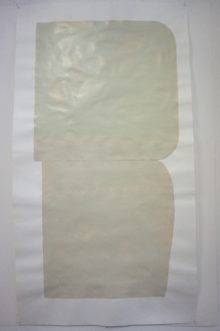
A sense of materiality
In the drawings a sense of materiality is created because of the immediacy of the drawing acts: the hardness and tightness of the tracings, the surface texture of the hatchings, the silky quality that arises from the slightly transparent lacquer and the shrinking of the paper. The specific pixeling of the lines in the drawings, that arise from the closeness of the lacquer to the line, makes the line vibrate and feel as a cut through matter, through a volume or a space. All these aspects are added to create and represent a material entity. The feeling of materiality can be so strong that it feels as if the shape wants to be cut out of the paper to exist in physical space, like an object. Now and then this actually happens, but most of the drawings remain in the limited space of the drawing paper.
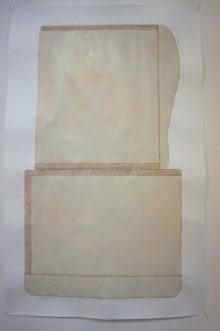
Sequence of acts
The drawings arise from a sequence of different acts where imagination plays an important role. The imagination of spatiality, corporality, sculpture and architecture. The drawings are abstract in themselves and through the abstraction one can imagine scale in the drawings, as well as volume, spatiality and materiality.
The drawings always possess distinct differences. These variations will arise from the generic quality of the method. In each drawing the sequence of the acts have a slightly different outcome because of the inherent coincidence of each act. Therefor each drawing demands different creative decisions to be made.
Making these drawings is part of an aesthetic and poetic desire. It is a search for a fragile quality in the drawing alongside the static and robust form qualities. Here imagination is a necessity in the drawing method. During the drawing process I follow a track where I then for example imagine one or more rooms, a sculpture or architecture. But the track is defined during the process of creative decisions, in the moment of speculation on what the outcome of the next act could be and it can therefor change during the process. The more I work with the method, the better I can anticipate the outcome of the acts.
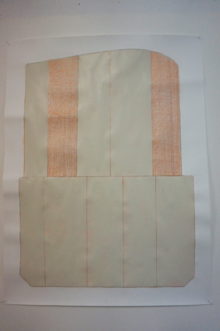
Generative qualities
The rooms of my studio trigger the imagination to draw mental projections of these room by means of my drawing method. These drawings can be read as horizontal or vertical sections of the studio spaces. I often add a straight line in one or the other direction of the drawing as to accentuate a connectivity between the spaces on a visual as well as on a conceptual level.
Different tracings that are repeatedly made in the same drawing as to create an overlap and dynamic of lines creates associations to dance or choreographic lines in space. The dynamics of the lines that the generative drawing method produces allows for the observer to make a mental projection to an imagined space.
The strong lines of the tracings allow us to see objects in the shapes, and on a more abstract level even to imagine sculpture. Blocks of stacked matter, somehow translucent with fragile and delicate borders made of thin pencil lines and traces of colour pencils.
On the other hand, aspects of monumentality and detail can make us imagine architecture. An architecture without specific context or function, just there in its existential presence like a monolith object.
